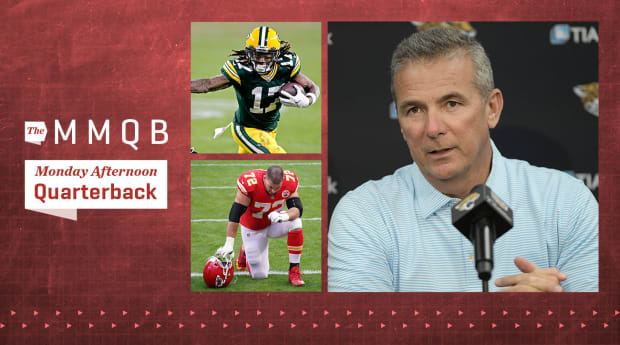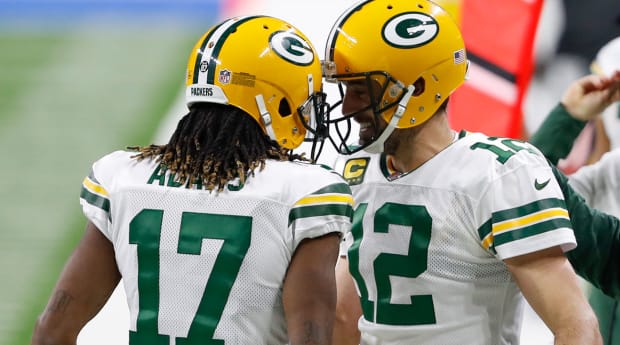If the Jaguars sign Tim Tebow, how many former Florida or Ohio State guys will want another shot?
I still have some fun post-draft nuggets to mine this afternoon, so let’s dive in …

• I’ve seen some of the response to my MMQB column on the Lions centering on Detroit’s decision not to trade down—and while I appreciate the analytics that lead people to believe that trading down is always the right thing, I think the makeup of this year’s draft class has to be considered as vital context on why things went the way they did. And over dozens and dozens of calls in the weeks leading up to the draft, and a lot more after it, I feel like the league consensus held that the nonquarterbacks in the ground broke down this way …
Consensus Tier 1: LSU WR Ja’Marr Chase, Florida TE Kyle Pitts
Tier 1/2 Split: Oregon OT Penei Sewell
Consensus Tier 2: South Carolina CB Jaycee Horn, Alabama WR DeVonta Smith, Northwestern OL Rashawn Slater, Alabama CB Patrick Surtain II, USC OL Alijah Vera-Tucker, Alabama WR Jaylen Waddle
Tier 1 was gone inside the top five. Our floater was the seventh pick. Tier 2 was gone by the 14th pick. And after that, there was a dropoff that left a lot of teams with a board full of second-round grades. So why didn’t the Lions trade down? Maybe because they saw Sewell as the final truly elite prospect left. Why did the Jets move up? Maybe because they saw a serious dropoff coming after Vera-Tucker came off the board. And after he did, the string of nonquarterbacks to go next—Zaven Collins, Alex Leatherwood, and Jaelan Phillips—were prospects that some teams loved and others didn’t like very much at all. All of which makes the reasoning for the Lions and Jets pretty simple. They saw the top group in this year’s draft as relatively small, like a lot of other teams did, and seized on the chance to pluck from them.
• One interesting thing that was raised to me with the Tim Tebow news on Monday: Signing the former Heisman winner could open a big can of worms for new Jaguars coach Urban Meyer with his ex-players. In the words of one person I talked to, “They’re going to be begging him to sign them” if he goes through with adding Tebow. The reality is the fringes of the NFL are filled with guys frustrated that they can’t quite seem to get that one last shot they feel like they need to break through. And in picking up a 33-year-old project tight end who hasn’t taken the field in a regular-season game in eight years, Meyer would seem to give license to any player he had at Ohio State (or even Florida, though that’s going back pretty far now) to come to him and ask, at the very least, for a tryout. Add that to the circus that follows Tebow around, and it gets a little harder to see what the upshot of Meyer’s signing off on this would be, other than the fact that the converted quarterback could be a messenger for what the coach is trying to establish in Jacksonville. Is having a program guy around worth all this? I’d think you could find someone else to be that guy, but that’s just me. And I say that with respect to Tebow for giving it a shot.
• The fact that we’re past last week’s mile-marker at which free-agent signings no longer count against the comp-pick formula should give a number of older vets a clearer view of what’s out there for them. This dynamic is, for sure, why the Ravens waited until six days ago to sign Alejandro Villanueva to replace Orlando Brown at right tackle. So it’ll be interesting to see what uber-accomplished players like Richard Sherman and Mitchell Schwarz (both of whom have rings and have taken care of their money) decide to do. My sense with Sherman is that when/if he signs somewhere will be based largely on finding the right fit; with Schwartz (who was cut, to be clear, which means the comp-pick thing wasn’t a factor for him), it might be a little more based on how he feels coming off back surgery.
• The Colts’ signing ex-Chiefs left tackle Eric Fisher is a smart, sensible risk for GM Chris Ballard, who was the No. 2 in scouting to GM John Dorsey when Kansas City spent the first pick on the 6' 7", 315-pounder back in 2013. Fisher’s career with the Chiefs was very up-and-down over eight years, but he was playing really good ball when he went down in the AFC title game. Kansas City, at that point, decided it was time to get younger at the position—a call that was based in large part because the Chiefs thought it’d be September or October before the 30-year-old Fisher would be back at full strength again, and because Achilles injuries can be problematic for big men getting up in years (Kansas City got to see that first-hand with Derrick Johnson). But for the Colts? Right now, Sam Tevi is the starting left tackle, taking the spot Anthony Castonzo occupied for a decade. And while playing Tevi for a full year would probably be problematic, particularly given Carson Wentz’s injury history, having him as a bridge to/insurance for Fisher makes sense. It also buys Ballard more time to find the long-term solution, assuming Fisher isn’t it, after he and the Colts staff wound up being lukewarm on the tackle group in the draft beyond Sewell and Slater.
• One person I should’ve mentioned in the Monday column: New England’s Matt Patricia. He’s played a role for Patriots coach Bill Belichick similar to the one Michael Lombardi filled a few years back. And that’s meant having a foot in the team’s reworked scouting process this year, where, as I see it, Patricia’s institutional knowledge of the place (which goes back to 2004) would be valuable as the coach set out to try and get everyone on the same page as the team reworked some of its practices.
• So in doing my Lions story, I did have something specific that I wanted to ask Dan Campbell. People who know the new Detroit coach said to me predraft, in essence, to forget the idea that he’d take a smallish receiver with his first pick in charge. And sure enough, the story went that Jaylen Waddle’s selection at No. 6 touched off a big-time eruption of cheers in the Lions’ war room, because it cleared the way to make Sewell a Lion. Then, the Lions took defensive linemen in the second and third rounds, so I had to ask Campbell if the run on big people was by design. Here was his answer: “Look, I do feel like probably at our core, [GM] Brad [Holmes] and myself, because of where he came from and where I came from, the big guys up front on your O-line and D-line are pivotal to having success. I know at my core I believe that. And I feel like he's the same way. However, that being said, we were not going to get pigeonholed into making a move that we didn't want to make, either. We were certainly open to taking a receiver if the right one had been there. But I think Brad spoke on it well, the way this thing fell for us and the moves that were made, it was just too hard to pass on [Sewell]. It just was. Now, am I excited to have three big guys? Yeah, I am. I can't lie to you. I'm very excited. But the plan was not to go in and say, ‘Listen, with our first three picks, let's find the best three big guys we can find.’ That wasn't the plan.” Holmes then added, “He’s right. That's also been brought up, will it be wide receiver? It really is like, s---, when Dan and I first got in these seats, there were a lot of holes on this roster. Let's be honest. Whether we would've went with a damn good player at wide receiver or a damn good player at tackle, it would've been a great football player that we were excited about. And that would've made an impact. … We try not to anchor ourselves on that in terms of we've got to get one position or another.”

• My belief is if you decode Davante Adams’s words to Fox’s Colin Cowherd from Monday, you hit a fault line in the dispute between the Packers and Aaron Rodgers. Adams told Cowherd that he didn’t know what would happen before adding, “A lot is still being figured out on his end.” He then said, “a few things need to get ironed out.” The contract, obviously, is one, as it relates to Rodgers’s job security (and how Jordan Love’s development plays into that). How aggressively the team is put together is another. But it feels to me like Adams was referring specifically to the hard feelings involved. And that one is about communication. Bottom line, giving Rodgers more of a heads up (he got a call when Green Bay was making the move for Love) that a move at his position might be coming a few days ahead of the 2020 draft, as I see it, would’ve made a world of difference, as would cluing the quarterback into the 2021 offseason plans. I don’t think it’s a good idea to let a quarterback run your team. But I do see where if the guy is the face of the franchise (and Rodgers clearly is), and is deep into his career, he’d want to be kept in the loop, and might take umbrage with surprises that affect him directly. The reality of today’s NFL is that quarterbacks are quasi-management anyway. And it’s hard to see teams resisting treating them as such getting much benefit from that.
• Speaking of quarterbacks’ influence: I do think the Buccaneers’ bringing Blaine Gabbert back might have Tom Brady’s fingerprints on it, to a degree. More experienced backups at the position can often be a resource for the starter, and Brady had that sort of resource at times in New England (Vinny Testaverde, Brian Hoyer, Damon Huard, etc.). That Gabbert has a decade under his belt in the league certainly would indicate he could bring some value to Brady over the course of a season.
• The single-digit jersey number changes are rolling in, and that’s going to take some getting used to.
• But it won’t be as weird as seeing “0” allowed in college football last year. That was bizarre, especially when the big guys wore it.
More NFL:
• Orr: Final Draft Grades: Analyzing Every Team's Picks
• Brandt: Rodgers and Packers Still in Fight for Control
• Breer: Ron Rivera's Expectations for Year 2 in Washington
• Report: Jags Expected to Sign Tim Tebow to One-Year Deal